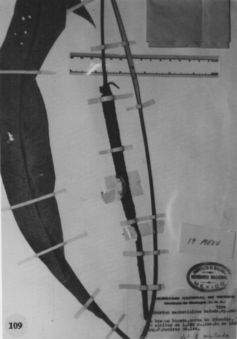




Anthurium machetioides Matuda,
Anales Inst. Biol. Univ. Nac. Mexico 22: 379, Fig. 7. 1952. TYPE: Mexico. Oaxaca? (see discussion): Chinanlla, 1,200 m, Ramirez 144 (MEXU, holotype).
Stems short, internodes short; cataphylls thin, to 6.5 cm long, drying brown, weathering to linear fibers, probably deciduous.
LEAVES with petioles 6-7 cm long, 4-5 mm diam., broadly sulcate adaxially, rounded abaxially; geniculum 4-5 mm long; blades oblanceolate, narrowly acuminate at apex, narrowly cuneate at base, 45-48 cm long, 6-8 cm wide, broadest above middle, matte on both surfaces (dry); the midrib prominently and narrowly raised above and below (dry); primary lateral veins 10-15 per side, departing midrib at 20¡-30¡ angle, curving down and joining collective vein; reticulate venation prominulous in dry specimens; collective vein arising from one of the primary lateral veins near the base, 3-4 mm from margin.
INFLORESCENCE equalling or longer than leaves; peduncle 40-48 cm long, to 5 mm diam., terete; spathe narrowly lanceolate, inserted at 45¡ angle on peduncle; spadix green, 20-24 cm long, 1.3 cm diam. at base, 6 mm diam. at apex; the flowers rhombic, 2-2.4 mm long, 2.4-2.6 mm wide; 13-14 flowers visible in the principal spiral, 9-10 flowers visible in the alternate spiral; pistils not emergent; stigma elliptic, slitlike, 0.5 mm long; stamens held level with tepals; anthers ovate.
INFRUCTESCENCE not seen. Fig. 109.
Anthurium machetioides is endemic to central Mexico on the Atlantic slope. The type was from the region of Chinantia in northeastern Oaxaca (a region comprising pan of 4 districts south of Valle Nacional), at 1,200 m and a second collection was made relatively near at 200 m in the District of Tuxtepec (probably San José Tuxtepec between Valle Nacional and Tuxtepec). The species is characterized by its oblong-linear leaves with a collective vein from near the base and primary lateral veins that are scarcely more prominent than the tertiary veins, and by the very elongate gradually tapered spadix. In describing the species Matuda indicated its relationship as section Leptanthurium; however, despite the fact that it has a collective vein from the base, its affinities are most likely with Anthurium schlechtendalii in section Pachyneurium, which often has a collective vein from near the base in juvenile leaves. It diners from A. schlechtendalii in its proportionally narrower leaves, the collective vein and by its proportionately much longer spadix.
 |
Mexico Oaxaca: Dtto. Tuxtepec, 200 m,, 24 November 1941, Martínez-Calderon 844 (LL, MICH).